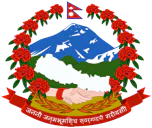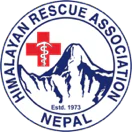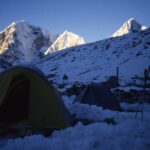
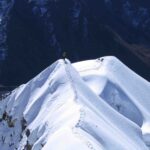
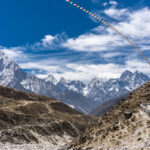
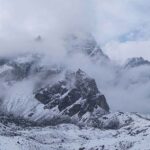
Explore the world's best trekking destination with native guides
Lobuche East Peak Climbing is an exciting adventures on least summited peaks around the high Khumbu Valley. However, at present from last few decades the Lobuche East Peak is getting popular among enthusiastic mountaineers and climbers. As a best way for practice climbing before planning major expeditions to higher peaks like Everest or similar heights mountains.
Lobuche East Peak, located west of Mt. Everest at a mere distance of 13 km/8.5 miles. The Lobuche with twin peaks west and the east, where Lobuche East Peak is more popular than the west. Due to its proximity and accessibility from the Lobuche settlement and Everest main trekking trail.
Lobuche East Peak towers high at 6,119 m/20,070 feet above the scenic Khumbu Valley. From the summit climbers can catch breathtaking panorama of surrounding near peaks with views of Mt. Everest.
The climb to the top of Lobuche East Peak is quite challenging with some technical difficulties to overcome. This is why the grading systems is listed as ‘TD’ means “Technical Difficult” but approachable. Where all types of trekkers and climbers can enjoy the exciting climb to Lobuche East Summit.
The grading is from the French and Swiss Alpine Climbing Classification Systems. Which is widely used around the world by the professional climbers and mountaineers. The best ways to describe the alpine style climbing of a day or more. Where all types of adventurers can enjoy the climb, having good climbing gear for safe and successful ascent and descent.
Lobuche East Peak Climbing is a combination of trekking, before the climb to the summit of Lobuche East Peak. Visiting first the landmarks of Khumbu and Nepal to Everest base camp and climb to Kalapathar, popular viewpoint.
Allows good acclimatization and exercise around the high altitude terrain, and then getting ready for the summit bid.
After a great adventure of lifetime experience, then heading back on the main trail to Lukla via Namche Bazaar. For the sweeping scenic flight to Kathmandu, on completing Lobuche East Peak Climbing and trekking around high Khumbu Valley.
The best seasons for Lobuche East Peak Climb, are spring and autumn. Spring starts from March to May, most days are sunny but can get cloudy in the late afternoon. Chances of light snowfall with cold mornings and nighttime sometimes. But beautiful with wildflowers in seasonal bloom, especially rhododendrons of various colors, around Hinku Valley.
The next best season is autumn/fall, which begins in September and ends in November. One of the high seasons for views and pleasant walks, sunny days most of the time in autumn. But gets dark soon, due to short sunlight hours, cold morning, and late afternoon till nighttime. Could get snowfall around Lobuche East climbing.
The route is straightforward with a signpost at each junction of the mid-ways, so there will be no confusion. The trails are nicely laid and good for walking until Lobuche, from Lobuche to Gorakshep and Everest base camp.
Can slightly changes of walking path, due to seasonal avalanches and rock falls, but nothing dangerous taking slow. Especially on rocky trails of big boulders with moraine of rocks, ice and glaciers, on crossing passes.
Including en route to Everest Base Camp. Few short uphill’s and downhill, but on leaving Dudh Koshi River, steep uphill on a winding trail to Namche Bazaar. As well as crossing suspension bridges over the same rivers a couple of times. From Namche Bazaar to Dingboche on gradual good path to follow. From Lobuche to Lobuche East Peak Base Camp is on rocky moraine, over dunes and glaciated path with rise in altitude. Situated in a hidden corner away from the major trekking route of Everest Base Camp.
Day 01: Fly to Lukla 2,846 m and trek to Phakding 2,645m-04 hrs.
Day 02: Trek to Namche Bazaar 3,440m/11,350 feet-06 hrs.
Day 03: At Namche for acclimatization and short scenic hike.
Day 04: Trek to Tengboche 3,867m-05 hrs.
Day 05: Trek to Dingboche 4,410 m-05 hrs.
Day 06: Rest day in Dingboche for acclimatization and short excursion.
Day 07: Trek to Lobuche 4,960 m-05 hrs.
Day 08: Trek to Everest base camp 5,364 m via Gorakshep 5,180 m and walk back to Gorakshep.
Day 09: Climb Kalapathar 5,643 m / 18,514 feet, trek to Lobuche East Peak Base Camp 4,865 m-05 hrs.
Day 10: Free Day for climbing preparation and practice exercise.
Day 11: Climb to High Camp 5,600 m /18,368 feet-04 hrs.
Day 12: Climb to Lobuche East Peak 6,119 m / 20,070 feet-07 hrs.
Day 13: Trek to Pangboche 3,900m-06 hrs.
Day 14: Trek to Namche Bazaar-07 hrs.
Day 15: Trek to Lukla-07 hrs.
Day 16: Fly to Kathmandu transfer to hotel with farewell dinner.
Breakfast, lunch, and dinner are prepared during the trek. The meals are basic, but will give you enough energy for your appetite. Fruit is also available after each meal.
During the trek, we stay in lodges or teahouses. These are simple in nature, but fully equipped. Do not expect too much luxury.
Depending on the itinerary of the trek and climb, normally it takes more than a week straight for the climb. Without visiting the Everest base camp, but including trek to Everest base camp takes more than two weeks.
The grade for Lobuche East Peak climbing is TD means Technical Difficult. As per French/Swiss Alpine Climbing Classification Systems. A straight forward climb with few tough technical difficulties to encounter before reaching the summit. All climbers requires adequate climbing gear for the safe climb and descend.
Normally an average person in good physical shape and in sound health can join in for the climb. Climbers of previous experience will be an advantage, for beginners we will have extra days for practice climb. Our guide will teach and supports you reach the summit, and back safely to base camp.
Medical and Travel Insurance, should cover any means of fastest transportation like using Helicopter service. Travel insurance should cover in case of flight delay and cancellation due to bad weather condition.
Certainly yes, as mentioned above for immediate evacuation in case of emergency situation if arise. The evacuation insurance usually applies for using helicopter service and medical treatments in Kathmandu or near about.
Can easily contact with your close one, relatives or friends where you can buy local cell phone re-charge card in Kathmandu. It works all around the country, or use your guide phone or from the nearest lodge, where STD / ISTD or SAT Phone is available. One can contact through the company that you booked with in case of emergency situation.
Facilities for charging batteries and electronic gadgets, available throughout the trek staying in a lodge, either by main hydroelectricity or solar power, where you need to pay as per hour and per gadgets. The last place on this trip is Lobuche,a small settlement with lodge having solar power. At the base camp for few days without any electricity power. The best is carrying a portable solar panel as the sun is bright around highest altitude for you to charge your gadgets.
Depending on the size of a group, for less than four people, one climbing guide as well with second guide to take care of the client requirement. For more than 6 to 10 people, with 2-3 climbing guides, with great experience. Who have summited other higher major mountain also.

